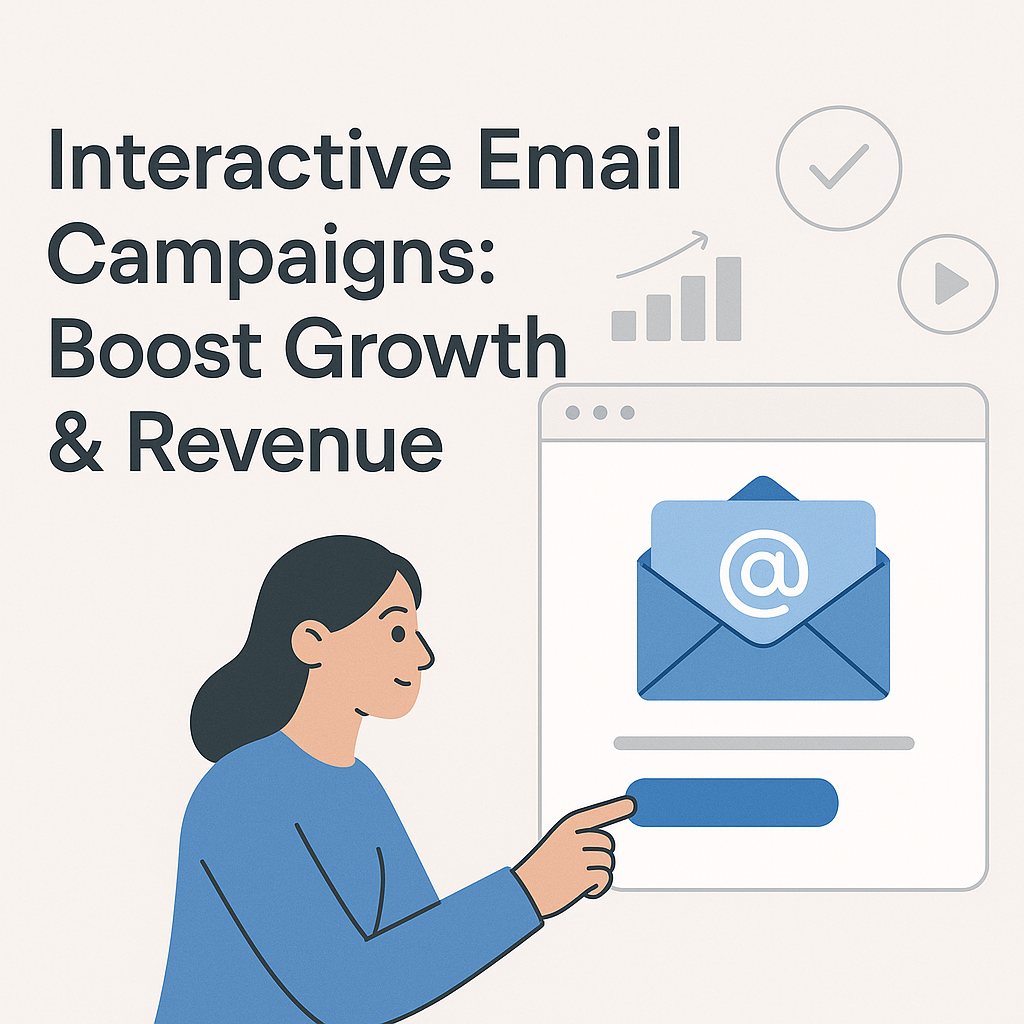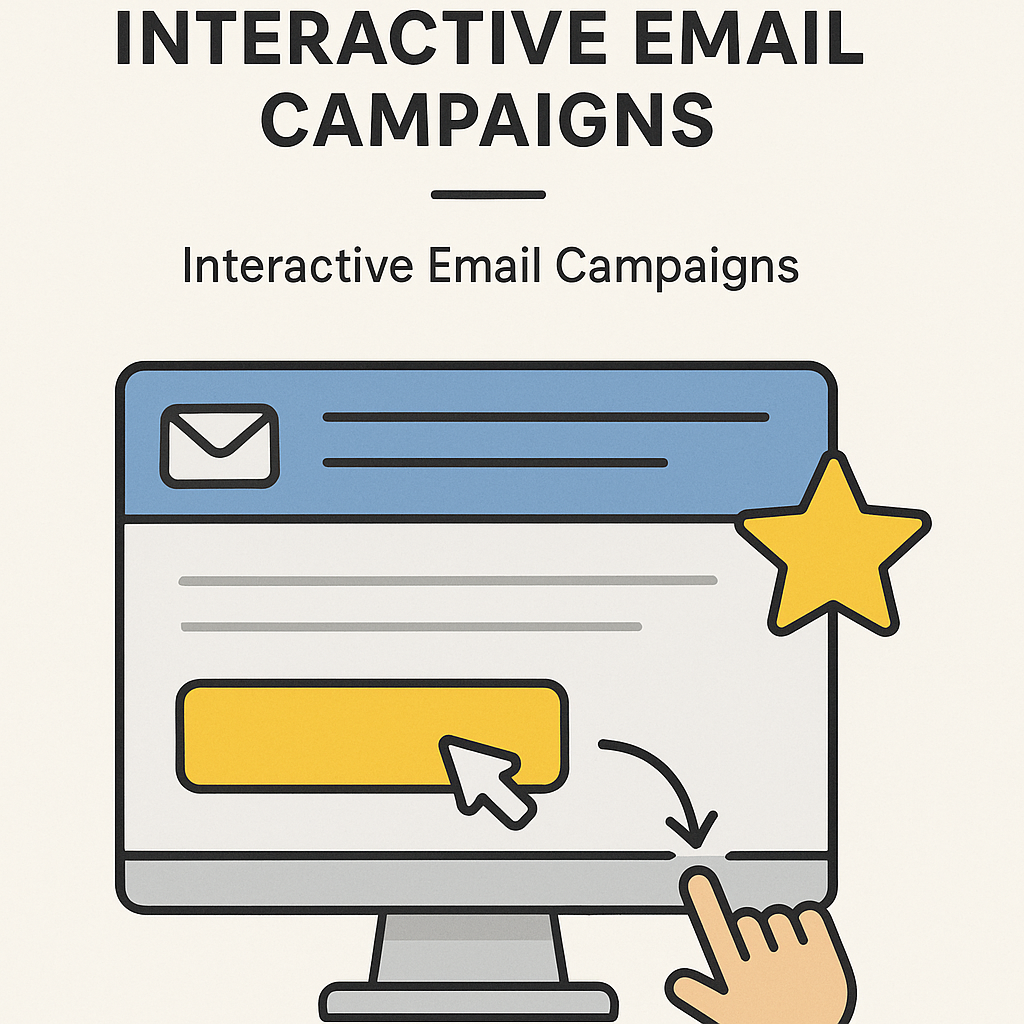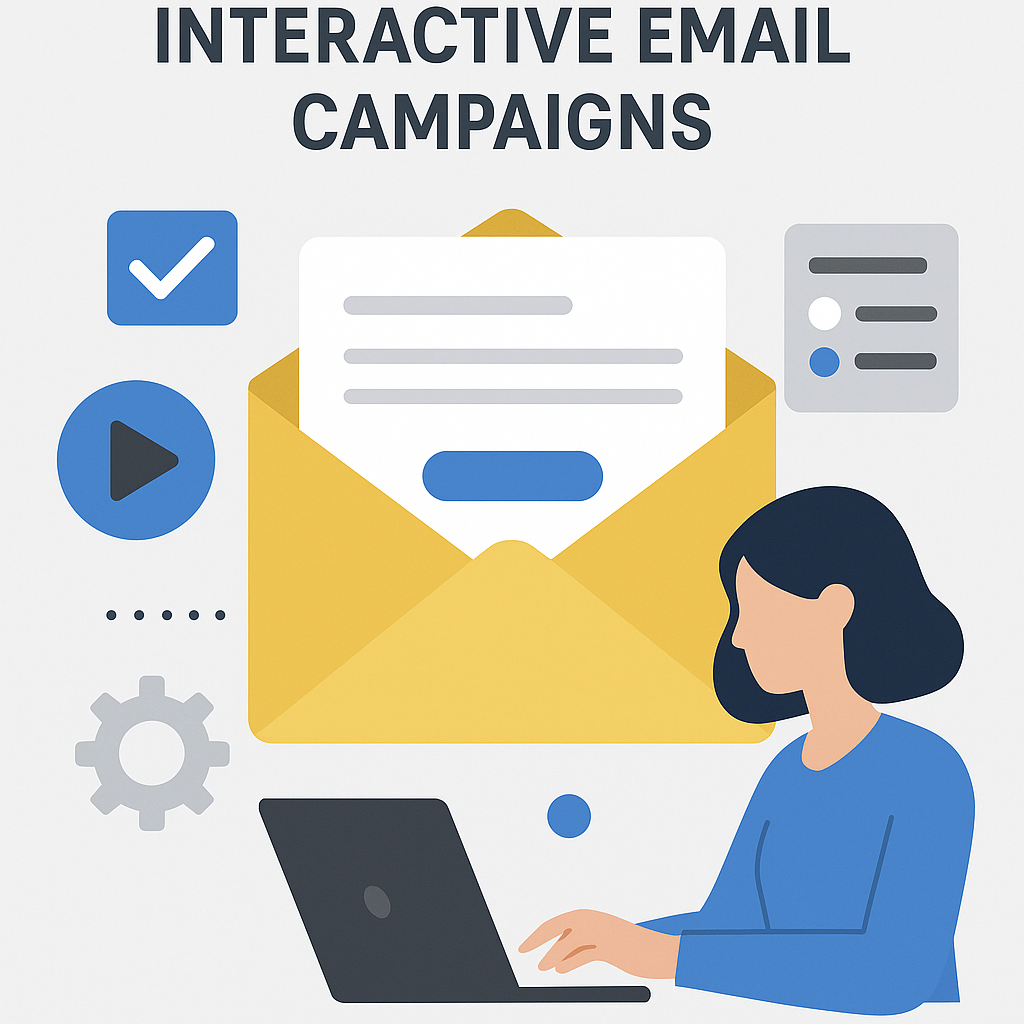Interactive Email Campaigns: Boost Growth & Revenue

In today's crowded digital landscape, getting your audience to not just open but *engage* with your emails can feel like an uphill battle. Static, one-way communication often gets lost in the noise, leading to dwindling open rates and missed opportunities for growth. But what if your emails could do more? What if they could actively involve your subscribers, gather instant feedback, and even drive conversions directly from the inbox? Welcome to the era of interactive email campaigns – a powerful strategy poised to revolutionize how you connect with your audience, boost engagement, and ultimately, drive significant revenue growth.
Gone are the days when an email was merely a digital letter or a promotional flyer. Modern marketing demands dynamism, and your email strategy should be no exception. By incorporating interactive elements, you transform a passive reading experience into an active, engaging journey. This isn't just about making emails look pretty; it's about creating a more valuable, efficient, and impactful communication channel that benefits both you and your subscribers.
What are Interactive Email Campaigns?
At its core, an interactive email campaign is an email that allows recipients to perform actions or engage with content directly within the email itself, without needing to navigate to a separate webpage. Think of it as bringing a mini-website or app-like experience right into the user's inbox.
Traditional emails are largely static. You might get a compelling image, persuasive copy, and a call-to-action (CTA) button that links to a landing page. While effective, this requires an extra step for the user, introducing potential friction points that can lead to drop-offs. Interactive emails, on the other hand, reduce this friction by embedding functionality.
These emails leverage technologies like AMP for Email, HTML5, and CSS to enable features such as:
- Clicking through image carousels
- Submitting a poll or survey
- Playing a video or GIF
- Adding an event to a calendar
- Filling out a form
- Receiving personalized content updates
The goal is to make the email experience more dynamic, personalized, and actionable, leading to deeper engagement and a more memorable brand interaction.
Key Interactive Elements to Include in Your Emails
The versatility of interactive emails lies in the sheer variety of elements you can incorporate. Choosing the right element depends on your campaign goals and audience. Here are some of the most effective interactive components:
Polls and Quizzes
These are fantastic for quick engagement and gathering immediate feedback or insights. They're fun, easy to participate in, and can be used for market research, gauging interest in new products, or simply to entertain your audience.
- Example: A fashion brand could send an email asking subscribers to vote on their favorite outfit from a new collection via an in-email poll.
- Benefit: High participation rates, valuable data on preferences, increased time spent with the email.
Surveys and Forms
Embedding short surveys or forms directly into an email streamlines the data collection process. This is invaluable for customer feedback, lead qualification, or event registration.
- Example: A SaaS company might send a post-onboarding survey directly in the email, asking users to rate their experience or provide quick feedback on a feature.
- Benefit: Reduced friction for respondents, higher completion rates compared to linking out, immediate data capture.
Image Carousels
Perfect for showcasing multiple products, features, or testimonials without cluttering the email or requiring multiple clicks. Recipients can swipe or click through a series of images and accompanying text.
- Example: An e-commerce store can display a "Shop the Look" carousel featuring different items from an outfit, each with a direct link to the product page.
- Benefit: Showcases more content in a compact space, encourages exploration, increases click-throughs to product pages.
Accordions
These elements allow you to hide and reveal content. They are excellent for presenting a lot of information in a clean, organized way, such as FAQs, detailed product specifications, or event schedules. Users click to expand sections they are interested in.
- Example: A travel company could use an accordion to detail different aspects of a vacation package (e.g., accommodation, activities, inclusions) without making the initial email overwhelming.
- Benefit: Improves readability, allows for more detailed content, caters to users who want to dive deeper.
Countdown Timers
Creating a sense of urgency is a classic marketing tactic. Dynamic countdown timers embedded in emails can count down to the end of a sale, the start of an event, or the launch of a new product.
- Example: An online retailer running a "Flash Sale" can use a countdown timer to show exactly how much time is left, driving immediate purchase decisions.
- Benefit: Creates urgency, encourages prompt action, boosts impulse purchases.
Ratings and Reviews
Allowing customers to rate a product or service directly within the email provides instant social proof and valuable feedback. This is a simple yet effective way to gather insights.
- Example: After a customer receives a product, an email can ask them to rate their purchase using a star rating system embedded in the email.
- Benefit: Easy for customers to provide feedback, generates valuable data for product improvement and marketing.
Embedded Videos and GIFs
While direct video embedding can still be tricky due to email client compatibility, using animated GIFs or linking to video content can significantly boost engagement and convey messages more dynamically than static images alone.
- Example: A software company could use a short, looping GIF to demonstrate a new feature in action.
- Benefit: Catches the eye, enhances storytelling, can explain complex features quickly.
Benefits of Interactive Emails for Engagement and Conversion
Integrating interactive elements into your email marketing strategy offers a cascade of benefits that directly impact your business's bottom line. These advantages stem from creating a more compelling and user-centric experience:
1. Skyrocketing Email Engagement
The most immediate benefit is a significant uplift in engagement. When users can interact, they spend more time with your email. This increased attention translates to higher open rates, more clicks, and a deeper connection with your brand. According to data from Litmus, interactive emails can achieve higher click-through rates (CTRs) and reduce bounce rates compared to traditional static emails.
2. Enhanced User Experience (UX)
Interactive emails provide a smoother, more intuitive experience. By reducing the need to click away to a website for simple actions like answering a question or browsing products, you create a more convenient journey for the recipient. This seamless interaction improves overall satisfaction and brand perception.
3. Invaluable Customer Data Collection
Interactive elements are goldmines for customer data collection. Polls, quizzes, and forms provide direct insights into customer preferences, opinions, and behaviors. This data is far richer and more specific than general clickstream data, allowing for highly targeted and effective marketing efforts.
4. Deeper Personalization
The data gathered from interactive elements can fuel hyper-personalization. Imagine sending follow-up emails that directly address a user's expressed preference from an in-email poll. This level of tailored communication makes subscribers feel understood and valued, fostering stronger relationships.
5. Improved Click-Through Rates (CTR)
When users engage with an interactive element, they are already demonstrating interest. This often leads to higher CTRs on the primary CTAs within the email. For instance, a carousel that allows users to browse multiple products is more likely to result in a click-through to a specific product page than a static grid of images.
6. Boosted Email Conversion Rates
By making it easier for users to take desired actions (like purchasing, signing up, or providing information) directly within the email, you directly influence email conversion rates. Reduced friction and increased engagement naturally lead to more completed actions and higher conversions.
7. Increased Brand Loyalty and Retention
A positive, engaging email experience makes a lasting impression. Customers who feel their needs are understood and catered to are more likely to remain loyal. Interactive campaigns contribute to a memorable brand interaction that can significantly improve customer retention.
8. Optimized Email Campaigns
The insights gained from interactive elements provide valuable data for email campaign optimization. You can learn what resonates with your audience, refine your messaging, and improve future campaign performance based on real user behavior and feedback.
How Interactive Emails Drive Growth and Revenue
The benefits of increased engagement and better data collection directly translate into tangible business growth and revenue generation. Here’s how:
- Lead Generation: Embedding forms for newsletter sign-ups, webinar registrations, or resource downloads directly in emails can capture leads more efficiently.
- Direct Sales: Features like "add to cart" buttons within emails (supported by some advanced platforms) or interactive product selectors can shorten the sales cycle and drive immediate purchases.
- Upselling and Cross-selling: By understanding customer preferences through interactive elements, you can send highly targeted offers for complementary or upgraded products, increasing average order value.
- Customer Feedback Loop: Using surveys and polls to gather feedback allows you to quickly identify pain points, improve products or services, and demonstrate that customer opinions are valued, which aids retention.
- Event Promotion: Interactive elements like RSVP buttons or polls for session preferences can increase event attendance and attendee satisfaction.
- Reduced Marketing Costs: Higher conversion rates and better engagement mean your marketing spend is more effective, leading to a better Return on Investment (ROI).
Ultimately, interactive email campaigns are not just about novelty; they are a strategic tool for creating a more efficient and effective marketing funnel, from initial engagement to final conversion.
Designing Effective Interactive Email Campaigns
Creating successful interactive emails requires careful planning and execution. Simply adding an interactive element without a clear strategy won't yield results. Here’s a guide to designing campaigns that resonate:
1. Define Clear Objectives
What do you want to achieve with this specific email? Is it to gather feedback, drive sales, increase event registrations, or educate your audience? Your objective will dictate the type of interactive element you choose and the overall message.
2. Know Your Audience and Segment Wisely
Understanding your subscribers is paramount. Use your existing customer data collection insights to segment your list. Tailor the interactive elements and content to the specific interests and behaviors of each segment. A quiz designed for new customers will differ greatly from a poll for loyal patrons.
3. Choose the Right Interactive Element
Match the interactive element to your objective.
- For quick feedback: Polls, ratings.
- For detailed insights: Surveys, forms.
- For product discovery: Carousels.
- For urgency: Countdown timers.
- For information delivery: Accordions.
4. Prioritize Simplicity and Value
Don't overcomplicate. Often, one well-executed interactive element is more effective than several poorly implemented ones. Ensure the interaction provides genuine value to the subscriber. Make it easy and enjoyable to participate.
5. Design for Mobile-First
A vast majority of emails are opened on mobile devices. Your interactive elements must be fully responsive and function flawlessly on various screen sizes and operating systems. Test rigorously across different devices and email clients.
6. Craft Compelling Copy and CTAs
Your introductory copy should clearly explain the interactive element and its benefit to the reader. The call-to-action should be clear and direct, guiding the user on what to do next.
7. Personalize Content
Leverage subscriber data to personalize the content within the interactive element. This could be addressing them by name, referencing past purchases, or tailoring quiz questions based on their known interests. This is a key aspect of effective personalized email content.
8. Ensure Fallback Options
Not all email clients support AMP for Email or advanced HTML5 features. Provide a static fallback version of your interactive content (e.g., a clear link to a web page) so that all subscribers can still access the core message and take action.
9. A/B Test Everything
Continuously test different interactive elements, copy, visuals, and CTAs to understand what performs best with your audience. This iterative process is crucial for ongoing email campaign optimization.
Tools and Strategies for Implementing Interactive Emails
Implementing interactive emails requires the right tools and a strategic approach. While building these from scratch is complex, many modern email marketing platforms and specialized tools offer robust support for interactive content.
When selecting tools, look for those that support AMP for Email, offer pre-built interactive templates, and provide analytics to track engagement with these elements. Email marketing automation platforms are essential for sending these campaigns at scale and integrating them with your broader marketing strategy.
The role of AI in email marketing is also becoming increasingly vital. AI can help analyze subscriber data to determine the most effective interactive elements, personalize content dynamically, and optimize send times for maximum engagement. For businesses looking to maximize their email efficiency and leverage advanced AI for communication, tools like an ai executive assistant can be invaluable. These platforms help manage complex workflows, analyze data, and ensure your outreach is timely and personalized, freeing up resources for strategic initiatives like crafting engaging interactive email campaigns.
Effective email engagement strategies often involve a combination of personalization, valuable content, and interactive elements. By streamlining your general email management, you can dedicate more resources to crafting these high-impact campaigns. Tools that offer advanced features for email campaign optimization and sophisticated customer data collection will be your best allies.
Consider exploring solutions that enhance your overall email productivity. For instance, optimizing how you manage your inbox can free up mental bandwidth. Tools like an email inbox cleaner can help triage incoming messages, while features found in comprehensive email management tools can streamline workflows. Similarly, leveraging an artificial assistant or virtual assistant services can offload routine tasks, allowing your team to focus on creative marketing efforts. Furthermore, employing decision making ai can help refine your strategies based on data-driven insights, ensuring your interactive campaigns are always aligned with your business goals.
Case Studies: Successful Interactive Email Campaigns and Lessons Learned
Real-world examples demonstrate the power of interactive emails:
Case Study 1: Sephora's Interactive Product Discovery
Sephora has been known to use interactive elements, such as carousels featuring new makeup collections or tutorials. Recipients can swipe through different looks or product combinations directly within the email, often with direct links to purchase. This reduces the friction to explore and buy.
- Lesson Learned: Visual appeal and product-centric interactivity drive significant engagement in e-commerce, especially in fashion and beauty.
Case Study 2: The New York Times' Personalized Content Modules
The New York Times has experimented with interactive modules that allow readers to customize the content they see in their newsletters, such as selecting preferred topics or authors. This enhances personalization and keeps readers engaged with the publication's offerings.
- Lesson Learned: Allowing users to curate their experience increases relevance and fosters a sense of control, leading to higher retention.
Case Study 3: Marriott's Event Engagement
Hotels and travel companies often use interactive elements to help customers plan their stays. Marriott, for instance, has used elements like embedded forms for booking preferences or polls to gauge interest in hotel amenities, making the planning process more engaging and informative.
- Lesson Learned: Interactive elements can simplify complex choices (like travel planning) and provide valuable data for service customization.
Case Study 4: A SaaS Company's Feature Feedback
A software-as-a-service company implemented a simple in-email survey asking users to rate their satisfaction with a new feature and provide a brief comment. They saw a 40% higher response rate compared to linking out to a survey page.
- Lesson Learned: Reducing the number of steps required for feedback dramatically increases participation rates.
These examples highlight that when interactive elements are relevant, well-designed, and easy to use, they create a superior customer experience and drive measurable results.
Conclusion: Embrace Interactivity for Exponential Growth
In the ever-evolving world of digital communication, standing out requires innovation. Interactive email campaigns offer a compelling pathway to cut through the noise, captivate your audience, and foster deeper connections. By transforming passive emails into dynamic experiences, you can significantly boost engagement, gather invaluable customer insights, enhance personalization, and ultimately, drive substantial growth in your email conversion rates.
From engaging polls and quizzes to streamlined forms and captivating carousels, the possibilities are vast. The key is to align your interactive elements with clear objectives, understand your audience, and prioritize a seamless user experience, especially on mobile. By leveraging the right tools and strategies, including the power of AI in email marketing and efficient email management solutions, you can unlock a new level of performance for your email marketing efforts.
Are you ready to elevate your email marketing from a one-way broadcast to a two-way conversation? Start exploring the potential of interactive elements today and watch your engagement, loyalty, and revenue soar. Your audience is waiting to interact!



